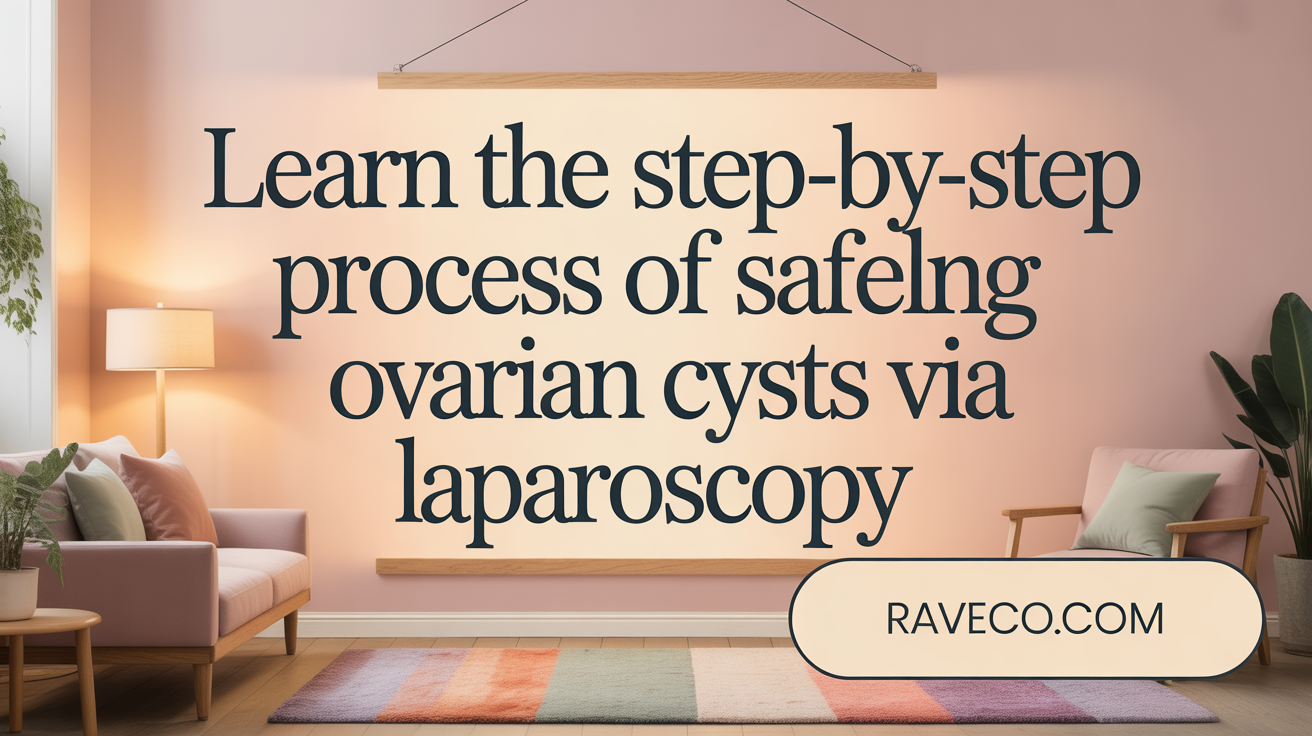Recognizing the Right Time to Address Female Infertility: Key Indicators and Expert Care in Queens

Understanding Modern Approaches to Ovarian Cyst Management
Ovarian cysts are common yet can pose significant health challenges when they cause symptoms or persist. Traditional open surgery, while effective, often involves lengthy recovery and more considerable risks. Laparoscopic surgery for ovarian cysts has emerged as a safer, faster, and less invasive alternative, revolutionizing the way these cysts are treated. This article explores the laparoscopic approach in depth, highlighting its advantages, procedural details, safety, efficacy, and impact on fertility, and comparing it to conventional methods.
What Is Laparoscopic Surgery for Ovarian Cysts?
 Laparoscopic ovarian cystectomy is a minimally invasive surgical procedure designed to remove ovarian cysts while preserving the ovary itself. Instead of a large incision, this technique uses several small cuts in the abdomen, typically around 5 millimeters each.
Laparoscopic ovarian cystectomy is a minimally invasive surgical procedure designed to remove ovarian cysts while preserving the ovary itself. Instead of a large incision, this technique uses several small cuts in the abdomen, typically around 5 millimeters each.
During the surgery, a laparoscope, a tiny camera connected to a light source, is inserted through one of these small incisions. This instrument provides a magnified view of the pelvic organs on a monitor, allowing the surgeon to see clearly and operate precisely.
To facilitate better visualization and space to work, the abdomen is usually inflated with carbon dioxide gas. This process, known as CO2 insufflation, lifts the abdominal wall away from the organs, creating a more accessible surgical field.
A key advantage of this approach is its ability to preserve ovarian tissue and function. It allows for the removal of cysts, including large or complex ones, with minimal damage to the healthy tissue, thereby maintaining fertility potential.
The entire procedure is performed under general anesthesia, ensuring the patient remains comfortable and pain-free throughout.
Compared to open surgery, laparoscopic cystectomy offers numerous benefits. These include less postoperative pain, minimal scarring, shorter hospital stays, faster recovery, and a quicker return to daily activities.
Overall, this method is now considered the preferred approach for managing benign ovarian cysts, especially for women seeking to preserve autonomy over their reproductive health.
Advantages and Benefits of Laparoscopic Ovarian Cystectomy

What are the advantages and benefits of laparoscopic ovarian cystectomy?
Laparoscopic ovarian cystectomy provides numerous benefits compared to traditional open surgery. This minimally invasive procedure involves making small incisions in the abdomen, through which a tiny camera and specialized surgical instruments are inserted. These small cuts lead to significantly less postoperative pain and reduced blood loss, enhancing patient comfort and safety.
One of the notable advantages is the shorter hospital stay, with most patients being discharged the same day or after a brief observation period. Recovery is generally faster, with many women returning to their normal activities within one to three weeks, which minimizes disruption to daily life.
Importantly, laparoscopy helps preserve ovarian tissue and function, making it especially beneficial for women wishing to maintain fertility. The preservation of ovarian health also lowers the risk of postoperative adhesions—scar tissues that can hamper reproductive health.
In addition to being safer, the procedure offers better cosmetic outcomes due to smaller scars, and it reduces the risks of serious complications such as infections, bleeding, or injury to adjacent organs.
Overall, laparoscopic ovarian cystectomy is considered a superior option for the effective removal of ovarian cysts, combining safety, efficiency, and enhanced recovery. It is widely regarded as the gold standard approach for managing benign ovarian cysts, offering patients a safer, less painful, and more cosmetically appealing treatment.
Detailed Procedural Steps of Laparoscopic Ovarian Cystectomy

What are the procedural steps involved in laparoscopic ovarian cystectomy?
Laparoscopic ovarian cystectomy is a carefully orchestrated procedure that begins with patient preparation and positioning. The patient is placed in the lithotomy position to allow optimal access to the abdomen. General anesthesia is administered to ensure comfort and immobility during the surgery.
The next step involves skin sterilization, followed by the creation of small incisions, typically 3-5, in the lower abdomen. These serve as access points for inserting the ports where the laparoscope and surgical instruments will be introduced.
A crucial step is the establishment of pneumoperitoneum — the inflation of the abdomen with carbon dioxide (CO2). This creates a working space and improves visualization. Usually, a Veress needle or a trocar is first used for this purpose, followed by the insertion of the main ports.
Once inside, a uterine manipulator may be placed if needed, to move the uterus and improve access, especially if the cyst is on the ovary. An initial survey of the pelvis is performed using the laparoscope to assess the cyst, surrounding structures, and to confirm the absence of unexpected pathology.
The targeted cyst is then carefully scored with monopolar scissors or a hook, applying appropriate energy settings to minimize bleeding. Dissection techniques involve both blunt and sharp methods to free the cyst from the ovarian tissue. Special attention is given to avoid rupture, especially in cases where malignancy cannot be entirely ruled out.
Upon successful mobilization, the cyst is placed into a specimen retrieval bag to prevent spillage during extraction. The use of such bags is critical to avoid seeding of cyst contents, which can be particularly important if the cyst is suspicious or malignant.
The surgeon may perform ovarian tissue repair after cyst removal, utilizing sutures or hemostatic agents to control bleeding and preserve as much healthy tissue as possible.
Finally, the surgical area is checked for hemostasis, and the ports are removed. The incisions are then closed with sutures or surgical glue. Postoperative measures include attention to adhesion prevention and ongoing evaluation of ovarian function. Overall, the procedure is designed to be safe, effective, and tissue-sparing, aiming at optimal preservation of fertility and ovarian health.
Safety and Efficacy of Laparoscopic Ovarian Cyst Surgery
Laparoscopic ovarian cystectomy is widely regarded as a safe and reliable method for removing ovarian cysts, especially when performed by experienced surgeons. Its safety profile features a low overall complication rate of approximately 13.3%, with major complications being rare at about 0.6%. Such serious issues may include injury to nearby structures like the bowel, ureters, or blood vessels, but these are uncommon. One of the significant advantages is its suitability even for large cysts; advancements in technique enable effective management of cysts exceeding 10 centimeters.
The procedure's minimally invasive nature results in less postoperative pain, shorter hospital stays, and quicker recovery times compared to traditional open surgery. It also offers better preservation of ovarian tissue, which is crucial for maintaining fertility. Nonetheless, risks such as intraoperative cyst rupture and potential detection of unexpected malignancies must be carefully considered. Adequate preoperative evaluation—including ultrasounds, blood tests like CA-125, and imaging—helps identify suspicious features, guiding the surgical approach.
In terms of effectiveness, laparoscopy demonstrates high success rates in cyst removal with minimal recurrence at follow-up intervals of 12, 18, and 24 months, typically around 4.5% to 17.9%. It also promotes better ovarian function post-surgery, as evidenced by stable ovarian reserve markers such as anti-Müllerian hormone (AMH) levels and antral follicle counts. These benefits translate into improved fertility prospects, especially for women wishing to preserve reproductive capacity.
An additional benefit of laparoscopic techniques, including recent innovations like vNOTES (vaginal natural orifice transluminal endoscopic surgery), is reduced adhesion formation and enhanced patient satisfaction despite slightly longer operative times. Overall, laparoscopic ovarian cystectomy stands as a highly effective, safe, and patient-friendly approach to managing ovarian cysts, with significant advantages over open surgical methods for suitable candidates.
Advanced Laparoscopic Techniques: LESS and Innovation in Cyst Management

What are advanced laparoscopic techniques, such as LESS, and what benefits do they offer for ovarian cyst surgery?
Advanced laparoscopic methods include technologies like Laparoendoscopic Single Site Surgery (LESS), which allows surgeons to perform ovarian cystectomy through a single, small incision often placed at the navel.
This approach significantly improves cosmetic results by minimizing visible scars, making the procedure nearly scarless. It reduces tissue trauma, resulting in less postoperative pain and faster recovery, enabling women to return to their daily activities sooner.
Emerging innovations such as laser-assisted surgeries and robotic-assisted techniques provide greater precision during cyst removal. These advanced tools help preserve ovarian function, which is especially important for women planning future pregnancies.
Compared to traditional open surgery, these minimally invasive techniques lower the risk of adhesion formation, decrease blood loss, and contribute to better fertility outcomes.
In summary, these cutting-edge techniques make ovarian cyst management safer and more convenient, offering women a less invasive option with comparable or improved effectiveness.
Cosmetic outcomes and patient satisfaction
One of the notable advantages of LESS and similar innovations is the superior cosmetic result. With only a single small incision, typically hidden within the navel, patients experience minimal visible scarring.
This benefit translates into higher satisfaction rates, especially among young women concerned about appearance. Studies show that patients report greater satisfaction regarding postoperative appearance and overall cosmetic outcomes.
Operating time and hospital stay comparisons
While traditional laparoscopy might take less time, recent studies comparing LESS with conventional laparoscopy have noted that LESS procedures tend to have longer operative durations, often averaging around 88 minutes versus 59 minutes for standard laparoscopy.
However, the lengthier operative time does not impact overall recovery. Hospital stays are generally shorter with LESS, with patients often discharged within 3-4 days, compared to 4-5 days for conventional approaches.
Novel techniques like laparoscopic guided minilaparotomy
Innovative approaches like laparoscopic guided minilaparotomy involve initial laparoscopy for diagnosis and cyst assessment, followed by a small, targeted incision to exteriorize the ovary for cystectomy. This combined method reduces tissue damage, minimizes complications, and preserves ovarian tissue.
The technique has demonstrated low recurrence rates and minimal impact on ovarian reserve, making it suitable for large, complex, or benign cysts.
Use of specialized instruments and robotics
The integration of advanced instruments such as high-definition cameras, laser devices, and robotic systems enhances precision during cyst removal. Robotics provide enhanced dexterity, 3D visualization, and tremor filtration, which are particularly advantageous in complicated cases.
These tools allow for meticulous dissection, reduce operative time in experienced hands, and contribute to better preservation of ovarian tissue.
Benefits for complex or large cysts
For large or complex cysts, these innovations are particularly beneficial. Techniques like laparoscopy combined with guided minilaparotomy enable removal of cysts exceeding 20 centimeters safely.
They reduce the need for large open surgeries, thereby decreasing postoperative pain, adhesion formation, and recovery time. This approach is also safer in managing cysts suspected of being malignant, with minimal spillage risk.
Postoperative follow-up and recurrence monitoring
Postoperative care involves regular ultrasound scans and serum marker assessments, such as CA-125 levels, to monitor for cyst recurrence. Advanced minimally invasive approaches have shown low recurrence rates, typically under 20% at two years.
Long-term follow-up is essential to ensure ovarian function preservation and detect any new cyst development early.
| Aspect | Traditional Laparoscopy | LESS/Innovative Techniques | Key Benefits |
|---|---|---|---|
| Incision size | Multiple small incisions | Single small incision | Better cosmetic outcome |
| Operating time | Usually shorter | Slightly longer | Improved patient experience |
| Hospital stay | 4-5 days | 3-4 days | Quicker recovery |
| Pain and scarring | Moderate pain, visible scars | Less pain, nearly scarless | Enhanced satisfaction |
| Suitability | Wide range of cysts | Complex, large cysts | Versatility |
| Use of technology | Standard laparoscopic tools | Robotics, laser | Precision and tissue preservation |
As technologies evolve, women undergoing ovarian cystectomy can expect safer procedures with faster recoveries and improved outcomes. For the most current information, searching terms like "latest advances in laparoscopic ovarian cyst surgery" can provide recent studies and innovations.
Indications, Limitations, and Suitability of Laparoscopic Surgery for Large or Complex Ovarian Cysts
What are the indications and limitations for laparoscopic removal of large or complex ovarian cysts?
Laparoscopic ovarian cystectomy is increasingly favored for managing large or complex cysts due to its minimally invasive nature, quicker recovery, and less scarring. It is particularly suitable when preoperative evaluations suggest the cyst is benign, based on ultrasound imaging, tumor markers like CA-125, and patient risk factors.
Generally, cysts up to about 20 centimeters can be treated laparoscopically using techniques such as controlled aspiration, cyst exteriorization, and microsurgical removal. The goal is to minimize damage to ovarian tissue while ensuring complete removal.
However, certain limitations affect the feasibility of laparoscopic management. Larger cysts, especially those exceeding 20 centimeters, pose challenges in extraction without rupture. The risk of intraoperative cyst rupture and spillage of contents, which may be malignant or cause peritonitis, increases with size.
Preoperative assessment plays a crucial role in determining suitability. If tests indicate a high suspicion of malignancy, surgeons often prefer open surgery (laparotomy) to allow comprehensive cancer staging and reduce the risk of spreading malignant cells.
In cases where extensive adhesions or complex cyst types (like dermoid cysts or endometriomas) are suspected to impede safe laparoscopic removal, conversion to open surgery may be necessary.
Overall, individual patient assessment—including detailed imaging and tumor markers—guides whether laparoscopic removal is appropriate. When performed by experienced surgeons, laparoscopy can be safe and effective for large or complex cysts, provided potential risks are managed properly.
Recovery and Fertility Considerations After Laparoscopic Ovarian Cystectomy

What is the recovery process like after laparoscopic ovarian cystectomy?
Recovery after laparoscopic ovarian cystectomy is generally quick and involves minimal hospital stay, with most patients able to leave the hospital the same or next day. Mild abdominal pain is common and tends to improve within a few days. Patients may experience 24-48 hours of light vaginal bleeding and mild fatigue, which requires resting during initial days. Full return to normal activities, including work, typically occurs within three to four weeks. For more vigorous activities such as running or heavy lifting, a waiting period of about two weeks is recommended.
Early mobilization, including leg exercises and the use of compression stockings, helps prevent blood clots. Patients are often encouraged to resume light eating and drinking shortly after surgery. Follow-up appointments are essential to monitor healing, ovarian function, and to detect any complications. Importantly, ovarian reserve usually recovers around six months after the procedure, supporting ongoing reproductive health.
How does laparoscopic ovarian cystectomy affect fertility and ovarian reserve?
This minimally invasive procedure is designed to preserve ovarian tissue and support fertility by removing cysts while minimizing damage to healthy ovarian tissue. Skilled surgeons carefully perform cystectomy to protect the ovarian cortex, which contains follicles vital for fertility. When done properly, laparoscopic ovarian cystectomy tends to maintain or even improve ovarian reserve relative to more destructive surgical options.
Factors influencing postoperative ovarian function include the cyst size, type, and how much of the ovarian tissue is involved. For example, in cases of endometriomas, preserving ovarian tissue is particularly important for fertility. Studies show that ovarian reserve markers, such as Anti-Müllerian Hormone (AMH) levels and Antral Follicle Count (AFC), usually experience minimal decline post-surgery, with a significant decrease considered unlikely. Many women experience improved chances of natural conception following successful cyst removal, especially when the surgery aligns with fertility-preserving goals.
Importance of surgeon skill in fertility preservation
The success of fertility preservation after ovarian cystectomy heavily depends on the surgeon’s experience and technique. Expert surgeons employ tissue-sparing methods, reduce unwanted removal of healthy tissue, and minimize the risk of adhesions. These practices help maintain ovarian function, optimize fertility outcomes, and reduce the chances of cyst recurrence. In cases involving complex cysts or conditions like endometriosis, proficiency in delicate surgical techniques ensures the best possible prognosis for future pregnancies.
The Future of Ovarian Cyst Management Is Minimally Invasive
Laparoscopic surgery for ovarian cysts represents a major advance in gynecologic surgery by combining safety, efficacy, and patient-centered benefits such as quicker recovery and fertility preservation. With continuous innovations like LESS and laparoscopic-guided minilaparotomy techniques, the approach is becoming increasingly versatile even for large or complex cysts. Surgeons skilled in these minimally invasive modalities can offer women effective cyst management with less pain, minimal scarring, and optimal reproductive outcomes. Given its clear advantages over traditional open surgery, laparoscopy remains the gold standard for ovarian cyst removal and a promising frontier for improving women’s health outcomes worldwide.
References
- Ovarian Cystectomy: Purpose, Procedure, Risks & Recovery
- Laparoscopic Ovarian Cystectomy Surgery - Dr Pankhuri Gautam
- Laparoscopy in Gynecology: A Safer & Faster Approach to Surgery
- a modified technique for management of benign large ovarian cysts
- Laparoendoscopic Single-Site Technique Contrasted with ...
- Outpatient Laparoscopic Ovarian Cystectomy
- Laparoscopic excision of ovarian cysts: is the stripping technique a ...





.png)